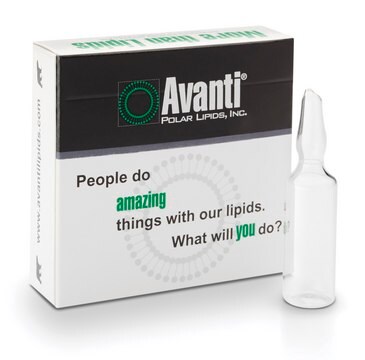780200C
Avanti
16:0 PE MCC
1,2-dipalmitoyl-sn-glycero-3-phosphoethanolamine-N-[4-(p-maleimidomethyl)cyclohexane-carboxamide] (sodium salt), chloroform
Synonyme(s) :
1,2-dihexadecanoyl-sn-glycero-3-phosphoethanolamine-N-[4-(p-maleimidomethyl)cyclohexane-carboxamide] (sodium salt)
About This Item
Produits recommandés
Pureté
>99% (TLC)
Forme
liquid
Conditionnement
pkg of 1 × 2.5 mL (780200C-25mg)
Fabricant/nom de marque
Avanti Research™ - A Croda Brand 780200C
Concentration
10 mg/mL (780200C-25mg)
Application(s)
advanced drug delivery
Conditions d'expédition
dry ice
Température de stockage
−20°C
Catégories apparentées
Description générale
Application
- in the preparation of liposomes for conjugation with human immune deficiency virus (HIV-1) envelope glycoprotein trimers
- in the preparation of oligonucleotide-modified vesicles
- in the functionalization of the flat silicon wafers
- in lipid vesicle preparation
Actions biochimiques/physiologiques
Conditionnement
Informations légales
Mention d'avertissement
Danger
Mentions de danger
Classification des risques
Acute Tox. 3 Inhalation - Acute Tox. 4 Oral - Carc. 2 - Eye Irrit. 2 - Repr. 2 - Skin Irrit. 2 - STOT RE 1 - STOT SE 3
Organes cibles
Central nervous system
Classe de danger pour l'eau (WGK)
WGK 3
Certificats d'analyse (COA)
Recherchez un Certificats d'analyse (COA) en saisissant le numéro de lot du produit. Les numéros de lot figurent sur l'étiquette du produit après les mots "Lot" ou "Batch".
Déjà en possession de ce produit ?
Retrouvez la documentation relative aux produits que vous avez récemment achetés dans la Bibliothèque de documents.
Notre équipe de scientifiques dispose d'une expérience dans tous les secteurs de la recherche, notamment en sciences de la vie, science des matériaux, synthèse chimique, chromatographie, analyse et dans de nombreux autres domaines..
Contacter notre Service technique
![16:0 PE MCC 1,2-dipalmitoyl-sn-glycero-3-phosphoethanolamine-N-[4-(p-maleimidomethyl)cyclohexane-carboxamide] (sodium salt), powder](/deepweb/assets/sigmaaldrich/product/images/137/780/423f2e9c-923f-4482-8df3-28d37cb1696c/640/423f2e9c-923f-4482-8df3-28d37cb1696c.jpg)


![18:1 PE MCC 1,2-dioleoyl-sn-glycero-3-phosphoethanolamine-N-[4-(p-maleimidomethyl)cyclohexane-carboxamide] (sodium salt), powder](/deepweb/assets/sigmaaldrich/product/images/396/705/1ea79c7e-9376-4ab2-af52-223e46ac9238/640/1ea79c7e-9376-4ab2-af52-223e46ac9238.jpg)






